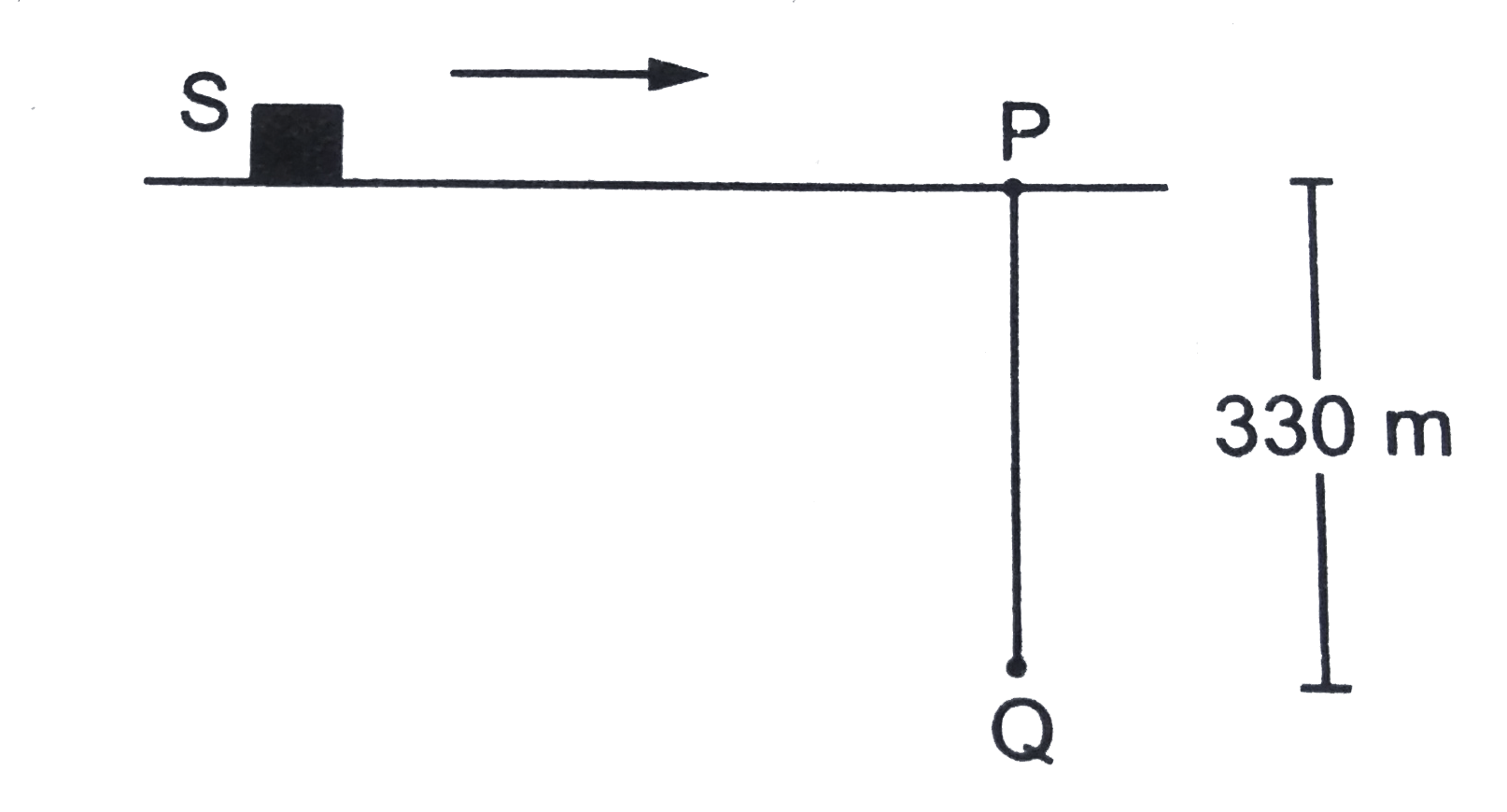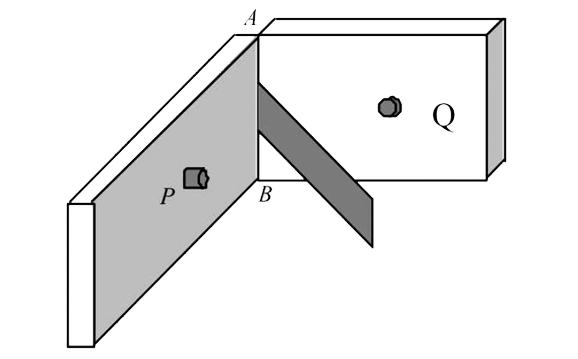At a prayer meeting, the disciples sing JAI-RAM JAI-RAM. The sound amplified by a loudspeaker comes back after reflection from a building at a distance of 80 m from the meeting. What maximum time interval can be kept between one JAI-RAM and the next JAI-RAM so that the echo S eed of does not disturb a listener sitting in the meeting. p sound in air is 320ms−1.
Here given s=80m×2=160m
v=320ms
So, the maximum time interval will be
t=sv=160320=0.5seconds
Topper's Solved these Questions
- SOUND WAVESBOOK - HC VERMACHAPTER - SOUND WAVESEXERCISE - Objective -2
5 Videos
- SOME MECHANICAL PROPERTIES OF MATTERBOOK - HC VERMACHAPTER - SOME MECHANICAL PROPERTIES OF MATTEREXERCISE - Exercises
32 Videos
- SPECIFIC HEAT CAPACITIES OF GASESBOOK - HC VERMACHAPTER - SPECIFIC HEAT CAPACITIES OF GASESEXERCISE - Exercises
35 Videos
Similar Questions
A man stationed between two parallel cliffs fires a gun. He hears the first echo after 1.5s and the next after 2.5s. What is the distance between the cliffs and when does the hear the third echo ? Take the speed of sound in air as 340m/s.
View SolutionTwo audio speakers are kept some distance apart and are driven by the same amplifier system. A person is sitting at a place 6.0 m from one of the speakers and 6.4 m from the other. If the sound signal is continuously varied from 500 Hz to 5000 Hz, what are the frequencies for which there is a destructive interference at the place of the listener? Speed of sound in air=320ms−1
View Solution
Knowledge Check
Not all sounds made by animals serve for communication, and we have only to turn to that extraordinary discovery of echo-location in bats to see a case in which the voice plays a strictly utilitarian role. To get a full appreciation of what this means we must turn first to some recent human inventions. Everyone knows that if a person shouts in the vicinity of a wall or a mountainside, an echo will come back. The further off this solid obstruction, the longer time will elapse for the return of the echo A sound made by tapping on the hull of a ship will be reflected from the sea bottom, and by measuring the time interval between the taps and the recent of the echoes, the depth of the sea at that point can be calculated. So was born the echo-sounding apparatus, now in general use in ships Every solid object will reflect a sound, varying accoridng to the size of and nature of the object. A shoal of fish will do this. So it is a comparatively simple step from locating the sea bottom to locating a shoal of fish. With experience, and with improved apparatus, it is now possible not only to locate a shoal, but to tell it is herring, cod,or other well-known fish, by the pattern of its echo.
A few years ago it was found that contain bats emit squeaks and by receiving the echoes they could locate and steer and by receiving the echoes they could locate and steer clear of obstacle of locate flying insects on which they feed. This echo-location in bats is often compared with radar, the principle of which is similar.
Which one of the following is correct?
An echo will come back if you shout nearAsolid obstructionBonly wallConly a mountainsideDthe seaNot all sounds made by animals serve for communication, and we have only to turn to that extraordinary discovery of echo-location in bats to see a case in which the voice plays a strictly utilitarian role. To get a full appreciation of what this means we must turn first to some recent human inventions. Everyone knows that if a person shouts in the vicinity of a wall or a mountainside, an echo will come back. The further off this solid obstruction, the longer time will elapse for the return of the echo A sound made by tapping on the hull of a ship will be reflected from the sea bottom, and by measuring the time interval between the taps and the recent of the echoes, the depth of the sea at that point can be calculated. So was born the echo-sounding apparatus, now in general use in ships Every solid object will reflect a sound, varying accoridng to the size of and nature of the object. A shoal of fish will do this. So it is a comparatively simple step from locating the sea bottom to locating a shoal of fish. With experience, and with improved apparatus, it is now possible not only to locate a shoal, but to tell it is herring, cod,or other well-known fish, by the pattern of its echo.
A few years ago it was found that contain bats emit squeaks and by receiving the echoes they could locate and steer and by receiving the echoes they could locate and steer clear of obstacle of locate flying insects on which they feed. This echo-location in bats is often compared with radar, the principle of which is similar.
Which one of the following is correct?
In the first paragraph, the writer says that bats use sound forAcommunicating with one anotherBcommunicating with animals in generalCsome practical purposeDfunNot all sounds made by animals serve for communication, and we have only to turn to that extraordinary discovery of echo-location in bats to see a case in which the voice plays a strictly utilitarian role. To get a full appreciation of what this means we must turn first to some recent human inventions. Everyone knows that if a person shouts in the vicinity of a wall or a mountainside, an echo will come back. The further off this solid obstruction, the longer time will elapse for the return of the echo A sound made by tapping on the hull of a ship will be reflected from the sea bottom, and by measuring the time interval between the taps and the recent of the echoes, the depth of the sea at that point can be calculated. So was born the echo-sounding apparatus, now in general use in ships Every solid object will reflect a sound, varying accoridng to the size of and nature of the object. A shoal of fish will do this. So it is a comparatively simple step from locating the sea bottom to locating a shoal of fish. With experience, and with improved apparatus, it is now possible not only to locate a shoal, but to tell it is herring, cod,or other well-known fish, by the pattern of its echo.
A few years ago it was found that contain bats emit squeaks and by receiving the echoes they could locate and steer and by receiving the echoes they could locate and steer clear of obstacle of locate flying insects on which they feed. This echo-location in bats is often compared with radar, the principle of which is similar.
Which one of the following is correct?
Echo-location was first discovered inAbatsBcodsCnavigationDradars
Two identical tuning forks vibrating at the same frequency 256 Hz are kept fixed at some distance apart. A listener runs between the forks at a speed of 3.0ms−1 so that he approaches one tuning-fork and recedes from the other. find the beat frequency bserved by the listener. Speed of sound in air =332ms−1.
 .
.
View SolutionTwo electric trains run at the same speed of v=90kmhr along a straight track one after the other with an interval of l=2.0km between them. At the instant when they are located symmetrically relative to point A at a distance of b=1.0km from the track (figure) both trains give a brief sound signal of the same frequency of v=50Hz. What will the number of beats beard per second at point (A) when the vibrations produced by the signals arrive at it? The speed of sound is v=350 m/ s. Round off to nearest integer.
'(##CEN_KSR_PHY_JEE_C17_E01_014_Q03##)'
View SolutionFigure shows a source of sound moving along the X-axis at a speed of 22ms−1 continuously emitting a sound of frequency 2.0 kHz which travels in air at a speed of 330∈s−1. A listener Q stands on the Y-axis at a distance of 330 m from the origin. At t = 0, the source crosses the origin P. (a) When does the sound emitted from the source at P reach the listener Q 9 (b) What will be the frequency heard by the listener at. this instant 9 (c) Where will the source be at this instant ?
 .
.
View SolutionTwo heavy metallic plates are joined together at 90∘ to each other. A laminar sheet of mass 30kg is hinged at the line AB joining the two heavy metallic plates. The hinges are frictionless. The moment of inertia of the laminar sheet about an axis parallel to AB and passing through its center of mass is 1.2 kg m2. Two rubber obstacles P and Q are fixed, one on each metallic plate at a distance 0.5m from the line AB. This distance is chosen so that the reaction due to the hinges on the laminar sheet is zero during the impact. Initially the laminar sheet hits one of the obstacles with an angular velocity 1 rad/s and turns back. If the impulse on the sheet due to each obstacle is 6 N-s,
(a) Find the location of the center of mass of the laminar sheet from AB.
(b) At what angular velocity does the laminar sheet come back after the first impact?
(c) After how many impacts, does the laminar sheet come to rest?

View SolutionTwo boys stand close to a long straight metal pipe and at some distance from each other. One boy fires a gun and the other hears two explosions , with a time interval of one second between them. If the velocity of sound in metal is 3630 m s−1 and in air is 330 ms−1, the distance between the two boys is
View Solution
